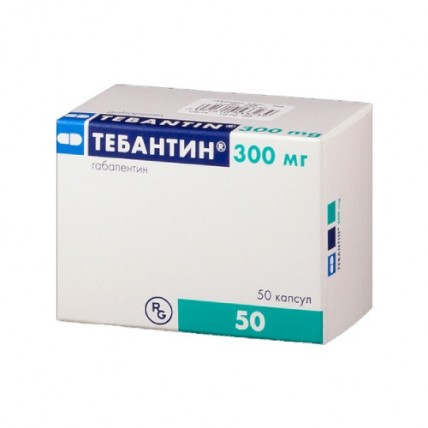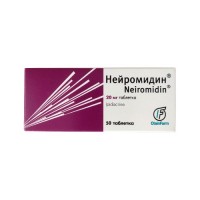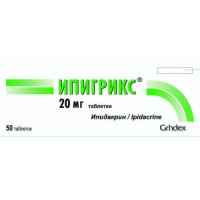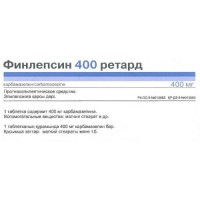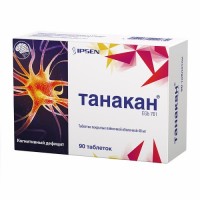Tebantin® (Gabapentin) 300 mg, 50 capsules
- $47.50
Indications for use
Epilepsy
Gabapentin is used as an adjunctive treatment for partial-onset seizures with and without secondary generalization in adults and children aged 6 years and older.
Gabapentin is used as monotherapy for the treatment of partial seizures with and without secondary generalization in adults and adolescents aged 12 years and older.
Peripheral neuropathic pain
Gabapentin is used to treat peripheral neuropathic pain, particularly diabetic neuropathy with pain and postherpetic neuralgia in adults.
List of information required before use
Contraindications
- hypersensitivity to the active substance or to any of the excipients of the drug
- lactase deficiency, lactose intolerance, galactose intolerance, glucose-galactose malabsorption syndrome
- acute pancreatitis
- children under 6 years of age as an additional remedy for the treatment of partial seizures with and without secondary generalization
- children under 12 years of age in the form of monotherapy for the treatment of partial seizures with and without secondary generalization
- pregnancy and breastfeeding period
Necessary precautions for use
Epilepsy; respiratory disorders; diseases of the nervous system; diseases of the respiratory system; renal dysfunction; simultaneous use of drugs that depress the central nervous system; elderly age; history of drug abuse.
Interactions with other drugs
Opioid analgesics
There have been reports of respiratory depression, symptoms of sedation, and death associated with the concomitant use of gabapentin and CNS depressants, including opioids.
In some reports, the authors concluded that the risk of these symptoms occurring is significantly increased when gabapentin is used in combination with opioid medications, particularly in debilitated patients, elderly patients, patients with serious underlying respiratory conditions, patients with polypharmacy, and suffering from substance abuse disorders.
When gabapentin 600 mg was administered 2 hours after morphine 60 mg extended-release capsules, there was a 44% increase in mean gabapentin AUC compared to gabapentin monotherapy. When opioids and gabapentin are used concomitantly, careful monitoring of patients is necessary for timely recognition of symptoms of CNS depression, such as drowsiness, lethargy, and respiratory depression. Doses of gabapentin or opioids should be reduced.
Antiepileptic drugs
There were no interactions between gabapentin and phenobarbital, phenytoin, valproic acid and carbamazepine.
The pharmacokinetics of gabapentin at steady state are similar in healthy subjects and in patients with epilepsy receiving other anticonvulsants.
Oral contraceptives
The simultaneous use of gabapentin and oral contraceptives containing norethisterone and/or ethinyl estradiol does not affect the pharmacokinetics of these drugs at steady state.
Antacids
The simultaneous use of gabapentin with antacids containing aluminum and magnesium is accompanied by a decrease in the bioavailability of gabapentin by approximately 24% . It is recommended to take gabapentin no earlier than 2 hours after taking antacids.
Probenecid
Renal excretion of gabapentin was not affected by probenecid.
Cimetidine
With simultaneous use with cimetidine, a slight decrease in the excretion of gabapentin by the kidneys was noted; this effect is probably not clinically significant .
Special Warnings
Severe skin adverse reactions
Severe cutaneous adverse reactions have been reported during treatment with gabapentin, including Stevens-Johnson syndrome, toxic epidermal necrolysis, and drug rash with eosinophilia and systemic reactions ( DRESS syndrome). These adverse reactions pose a threat to life, including death. When prescribing the drug, patients should be informed of the signs and symptoms of severe skin reactions and advised to carefully monitor their occurrence. If signs and symptoms suggest the development of a severe skin reaction, discontinue gabapentin immediately and consider alternative treatment if necessary.
If a patient develops a serious reaction such as Stevens-Johnson syndrome, toxic epidermal necrolysis, or DRESS syndrome while using gabapentin, re-use of gabapentin in that patient should be avoided.
Anaphylactic reactions
Gabapentin may provoke the development of anaphylactic reactions. In reported cases, the following symptoms and signs were noted: difficulty breathing, swelling of the lips, throat and tongue, a marked decrease in blood pressure, requiring emergency medical attention. Patients should be warned that if signs or symptoms of anaphylaxis develop, they should stop taking the drug and seek medical attention.
Suicidal thoughts and behavior
While taking antiepileptic drugs for various indications, cases of suicidal thoughts and behavior have been reported. The mechanism by which this risk increases is unknown. In the post-marketing period, cases of suicidal ideation and behavior have been observed in patients receiving gabapentin.
Patients and caregivers should be aware of the need to seek medical help if suicidal thoughts or behavior occur. Patients should be monitored for suicidal thoughts and behavior and appropriate treatment. If suicidal thoughts and behavior occur, discontinuation of gabapentin treatment should be considered.
Acute pancreatitis
If acute pancreatitis develops during treatment with gabapentin, discontinuation of the drug should be considered.
Convulsions
The possibility of “rebound” epileptic seizures when using gabapentin has not been proven, however, abrupt cessation of the use of anticonvulsants in patients with epilepsy can lead to the development of status epilepticus.
As with other antiepileptic drugs, some patients may experience an increase in the frequency or occurrence of a different type of seizures during treatment with gabapentin.
As with other antiepileptic drugs, in patients with refractory epilepsy receiving multiple antiepileptic drugs, attempts to stop the other drugs to switch to gabapentin monotherapy are rarely successful.
Gabapentin is not thought to be effective for primary generalized seizures, such as absence seizures, and may worsen such seizures in some patients. Therefore, gabapentin should be used with caution in patients with mixed seizures, including absence seizures.
Dizziness, drowsiness, loss of consciousness, confusion and impaired mental functioning
During treatment with gabapentin, cases of dizziness and drowsiness have been observed, which may increase the possibility of accidental injury (from a fall). Cases of confusion, loss of consciousness and impaired mental functioning have also been reported. Therefore, patients should be advised to exercise extreme caution until they are aware of the possible effects of the drug.
Concomitant use with opioids and other drugs that depress the central nervous system
Patients receiving concurrent central nervous system (CNS) depressants, including opioid analgesics, should be monitored for symptoms of CNS depression, such as somnolence, sedation, and respiratory depression. With the simultaneous use of gabapentin and morphine, an increase in the concentration of gabapentin in the blood plasma may be observed. The dose of gabapentin or concomitantly used CNS depressants, including opioids, should be reduced accordingly.
Caution is advised when coadministering gabapentin with opioids due to the risk of CNS depression. In an observational population-based nested case-control study of patients using opioid medications, concomitant use of gabapentin was associated with an increased risk of opioid-related death compared with use of prescription opioid medications alone.
Respiratory depression
Cases of severe respiratory depression have been reported during the use of gabapentin. The risk of developing this adverse reaction may be increased with impaired respiratory function, diseases of the respiratory or nervous system, renal failure, with simultaneous use of drugs that depress the central nervous system, as well as in the elderly. Dose adjustment may be required in patients in this group.
Elderly patients (over 65 years old)
For neuropathic pain, patients aged 65 years and older had a higher incidence of somnolence, peripheral edema, and asthenia than younger patients. With the exception of these results when examined in this age group, the adverse reaction profile did not differ from that in younger patients.
Misuse, potential for abuse and dependence
Gabapentin may cause drug dependence, which may develop when taking therapeutic doses. Cases of abuse and misuse have been reported. Patients with a history of substance abuse may be at higher risk of developing abuse, misuse, and dependence when using gabapentin. Gabapentin should be used with caution in such patients. The risk of misuse, abuse, or dependence should be carefully assessed before gabapentin is prescribed.
Patients receiving gabapentin should be monitored for signs of misuse, abuse, or dependence, such as tolerance, dose escalation, and drug-seeking behavior.
Withdrawal syndrome
After cessation of short-term and long-term treatment with gabapentin, withdrawal syndrome was observed. Withdrawal symptoms may develop after stopping the drug, usually within 48 hours. The most commonly reported symptoms were anxiety, insomnia, nausea, pain, sweating, tremors, headache, depression, malaise, dizziness and malaise. The occurrence of withdrawal symptoms after stopping gabapentin therapy may indicate drug dependence. Patients should be informed about this at the start of treatment. If gabapentin treatment must be discontinued, it is recommended that this be done gradually over at least one week, regardless of the indication for use.
Laboratory research
When semiquantitatively determining total protein in urine using a test strip, a false positive result may be obtained. Therefore, if a positive dipstick test result is obtained, it should be confirmed by other analytical methods, such as the biuret method, turbidimetric method or dye binding method, or only the specified alternative methods should be used.
Excipients
Tebantin contains lactose. Patients with rare hereditary diseases such as lactase deficiency, lactose intolerance, galactose intolerance, glucose-galactose malabsorption syndrome should not take this drug.
Use in pediatrics
The use of tebantine is not recommended in children under 6 years of age.
The effects of long-term (more than 36 weeks) treatment with gabapentin on learning, mental abilities and development in children and adolescents have not been well studied. In this regard, the benefits of long-term treatment with gabapentin must be weighed against the potential risks.
During pregnancy or lactation
General risk associated with epilepsy and antiepileptic drug use
Women treated with anticonvulsants have a 2- to 3-fold increased risk of having children with congenital anomalies. The most common conditions are cleft lip and palate, cardiovascular malformations, and neural tube defects. When multiple anticonvulsants are used, the risk of birth defects may be higher than with monotherapy, so it is the preferred treatment and should be used whenever possible. Women of childbearing potential, and all women who may become pregnant, should seek advice from a qualified healthcare professional. If a woman is planning a pregnancy, the need to continue anticonvulsant therapy should be re-evaluated. Anticonvulsant therapy should not be discontinued abruptly, as it may lead to breakthrough seizures with serious consequences for the mother and child. In rare cases, developmental delays have been observed in children whose mothers have epilepsy. However, it is impossible to determine whether developmental delay is due to genetic or social factors, maternal illness or anticonvulsant therapy.
Risk associated with gabapentin
Gabapentin crosses the placenta in humans.
There are no or limited reliable data on the use of gabapentin in pregnant women. Gabapentin has been shown to be reproductively toxic in animals. People have no data regarding the possible risk. Therefore, gabapentin should be used during pregnancy only if the expected benefit to the mother justifies the possible risk to the fetus.
It is not possible to draw a definitive conclusion about the association of gabapentin with an increased risk of congenital anomalies when used during pregnancy due to the presence of epilepsy itself and the concomitant use of other antiepileptic drugs in every reported case.
There have been reports of withdrawal syndrome in neonates exposed to gabapentin in utero. Concomitant prenatal exposure to gabapentin and opioids may increase the risk of neonatal abstinence syndrome. Newborns should be closely monitored. Gabapentin passes into breast milk. Its effect on the baby is unknown, so caution should be used when using it during breastfeeding. During breastfeeding, gabapentin should only be prescribed if the benefit to the mother clearly outweighs the risk to the infant.
Features of the drug's influence on the ability to drive a vehicle or potentially dangerous mechanisms
Gabapentin may have a weak or moderate effect on the ability to drive vehicles and use machines.
Gabapentin affects the central nervous system and may cause drowsiness, dizziness, or other similar symptoms. Even if these undesirable effects are mild or moderate in severity, they can be potentially dangerous when driving or operating machinery. This risk is especially high during the initial stages of treatment or after increasing the dose of the drug.
Recommendations for use
Dosage regimen
Table 1 shows the recommended titration scheme for the initial dose of the drug in adults and adolescents aged 12 years and older when used for all indications.
Recommendations for dosing of the drug in children under 12 years of age are presented under a separate subheading below in this section.
Table 1.
Discontinuation of gabapentin therapy
According to current clinical practice standards, if discontinuation of gabapentin treatment is necessary, a gradual dose reduction over at least one week is recommended, regardless of the indication for use.
Epilepsy
Epilepsy in most cases requires long-term treatment. The dose of the drug is selected by the attending physician depending on individual tolerability and effectiveness of the drug.
Adults and teenagers (over 12 years old)
The effective dose is 900 – 3600 mg/day. At the beginning of treatment, the drug can be used according to the scheme of gradually increasing the initial dose shown in Table 1, or 300 mg 3 times a day on the first day. Subsequently, depending on the effectiveness and tolerability of the drug, an additional stepwise increase in the dose by 300 mg/day is possible every 2 to 3 days until a maximum dose of 3600 mg/day is reached. In some patients, a slower dose increase may be required. A dose of 1800 mg/day can be achieved no earlier than after 1 week, a dose of 2400 mg/day - after 2 weeks, a dose of 3600 mg/day - after 3 weeks.
Gabapentin therapy was well tolerated at doses up to 4800 mg/day. The daily dose should be divided into 3 doses. To avoid resumption of seizures, the maximum interval between doses of the drug should not exceed 12 hours.
Children
Children aged 6 years and older
The initial dose is 10 – 15 mg/kg/day. The effective dose is achieved by gradually increasing the dose over approximately 3 days. The effective dose of gabapentin in children aged 6 years and older is 25 – 35 mg/kg/day. The drug was well tolerated when used in doses up to 50 mg/kg/day. The total daily dose should be divided into 3 single doses, the maximum interval between doses of the drug should not exceed 12 hours.
Note: not all doses used in children can be obtained when using the drug Tebantin ; the use of another drug containing gabapentin may be required.
There is no need to monitor gabapentin plasma concentrations to optimize therapy. In addition, it can be used in combination with other anticonvulsants without taking into account changes in its plasma concentration or the concentrations of other anticonvulsants.
Peripheral neuropathic pain
Adults
At the beginning of treatment, the drug can be used according to the scheme of gradually increasing the initial dose shown in Table 1. As an alternative, the drug can be used at an initial dose of 900 mg / day, divided into 3 doses. Subsequently, depending on the patient’s response to therapy and tolerability of the drug, a stepwise increase in the dose by 300 mg/day every 2–3 days is possible until a maximum dose of 3600 mg/day is reached. In some patients, a slower dose increase may be appropriate. A dose of 1800 mg/day can be achieved no earlier than after 1 week, a dose of 2400 mg/day after 2 weeks, and a dose of 3600 mg/day after 3 weeks.
The effectiveness and safety of the drug for the treatment of peripheral neuropathic pain (in particular, diabetic neuropathy with pain syndrome and postherpetic neuralgia) for a period of more than 5 months have not been studied. If the patient requires continued therapy for longer than 5 months, the attending physician should evaluate the patient's clinical condition and determine the need for additional therapy.
Recommendations for all indications
In patients in serious condition (for example, with low body weight, after organ transplantation, etc.), the dose should be increased slowly, either using smaller doses of the drug or taking longer intervals between dose increases.
Special patient groups
Elderly patients (over 65 years old)
In elderly patients, dose adjustment may be required due to age-related decline in renal function (see Table 2). In elderly patients, phenomena such as drowsiness, peripheral edema and asthenia may be more common.
Patients with impaired renal function
In patients with impaired renal function and/or those on hemodialysis, it is recommended to adjust the dose of the drug as described in Table 2.
Table 2. Dose of gabapentin in adults according to renal function status
* The total daily dose of the drug should be divided into 3 equal doses. In patients with impaired renal function (creatinine clearance <79 ml/min), a dose reduction of the drug is indicated.
** With a daily dose of 150 mg, you should take 300 mg every other day.
*** In patients with creatinine clearance <15 ml/min, the daily dose should be reduced in proportion to creatinine clearance (for example, in patients with creatinine clearance 7.5 ml/min, the daily dose of the drug should be 2 times lower than in patients with creatinine clearance creatinine 15 ml/min).
Patients on hemodialysis
In anuric patients on hemodialysis who have never received treatment with gabapentin, it is recommended to use the drug at a loading dose of 300-400 mg, and then 200-300 mg after each 4-hour hemodialysis session. On non-dialysis days, gabapentin is not used.
In patients with impaired renal function undergoing hemodialysis, the maintenance dose of gabapentin should be determined in accordance with the recommendations given in Table 2. In addition to the maintenance dose, it is recommended to use 200-300 mg of gabapentin after each 4-hour hemodialysis session.
Method and route of administration
For oral administration.
Gabapentin can be used with or without food. The capsules should be swallowed whole with plenty of water (eg a glass of water).
Measures to be taken in case of overdose
There were no acute life-threatening toxic effects even when taking up to 49 g of gabapentin per day.
Symptoms of overdose included dizziness, double vision, slurred speech, drowsiness, loss of consciousness, lethargy, and mild diarrhea. All patients recovered with maintenance therapy. Decreased absorption of gabapentin at higher doses may help reduce gabapentin absorption in overdose and thus minimize toxicity.
An overdose of gabapentin, especially in combination with other drugs that depress the central nervous system, can lead to coma.
Although gabapentin can be eliminated by hemodialysis, current experience suggests that this is not usually necessary. However, hemodialysis may be appropriate in patients with severe renal failure.
In studies of gabapentin administered to animals at doses up to 8000 mg/kg, the oral lethal dose of the drug was not determined. Signs of acute toxicity in animals included ataxia, difficulty breathing, ptosis, decreased activity, or restlessness.
Recommendations for seeking advice from a healthcare professional to explain how to use the drug
If you have any doubts about how to use the drug, consult your doctor.
Description of adverse reactions that occur with standard use of drugs and measures that should be taken in this case
Adverse reactions presented below are listed according to frequency of occurrence.
Often
- viral infections
- drowsiness, dizziness, ataxia
- fatigue, fever
Often
- pneumonia, respiratory tract infections, urinary tract infections, otitis media
- leukopenia
- anorexia or increased appetite
- hostility, confusion, emotional lability, depression, anxiety, nervousness, impaired thinking
- convulsions, hyperkinesia, dysarthria, amnesia, tremor, insomnia, headache, sensory disturbances (paresthesia, hypoesthesia), coordination disorders, nystagmus, increased/decreased or absent tendon reflexes
- visual impairment (amblyopia or diplopia)
- vertigo
- arterial hypertension, symptoms of vasodilation
- shortness of breath, bronchitis, pharyngitis, cough, rhinitis
- vomiting, nausea, dental disease, gingivitis, diarrhea, abdominal pain, dyspepsia, constipation, dry mucous membrane of the oral cavity or pharynx, flatulence
- swelling of the face, purpura (most often described as bruising due to physical trauma), rash, itchy skin, acne
- arthralgia, myalgia, back pain, muscle twitching
- impotence
- peripheral edema, gait disturbance, asthenia, pain of various localizations, general malaise, flu-like syndrome
- decrease in the number of leukocytes, increase in body weight
- accidental injuries, fractures, abrasions
Infrequently
- excitement
- allergic reactions (including urticaria)
- hyperglycemia (most common in patients with diabetes mellitus)
- hypokinesia, mental impairment
- feeling of heartbeat
- generalized edema
-increased activity of alanine aminotransferase, aspartate aminotransferase and bilirubin concentration in blood plasma
-falls
- dysphagia
Rarely
- hypoglycemia (most common in patients with diabetes)
- loss of consciousness
-respiratory depression
Frequency unknown* (cannot be estimated from available data)
- thrombocytopenia
- hypersensitivity reactions, including systemic reactions with manifestations such as fever, rash, hepatitis, lymphadenopathy, eosinophilia and other symptoms and signs; anaphylaxis
- hyponatremia
- suicidal thoughts, hallucinations, drug addiction
- movement disorders (including choreoathetosis, dyskinesia, dystonia)
- noise in ears
- pancreatitis
- hepatitis, jaundice
-Stevens-Johnson syndrome, toxic epidermal necrolysis, drug skin rash, including eosinophilia and systemic reactions (DRESS syndrome), erythema multiforme, angioedema, alopecia
- rhabdomyolysis, myoclonus
- acute renal failure
Epilepsy
Gabapentin is used as an adjunctive treatment for partial-onset seizures with and without secondary generalization in adults and children aged 6 years and older.
Gabapentin is used as monotherapy for the treatment of partial seizures with and without secondary generalization in adults and adolescents aged 12 years and older.
Peripheral neuropathic pain
Gabapentin is used to treat peripheral neuropathic pain, particularly diabetic neuropathy with pain and postherpetic neuralgia in adults.
List of information required before use
Contraindications
- hypersensitivity to the active substance or to any of the excipients of the drug
- lactase deficiency, lactose intolerance, galactose intolerance, glucose-galactose malabsorption syndrome
- acute pancreatitis
- children under 6 years of age as an additional remedy for the treatment of partial seizures with and without secondary generalization
- children under 12 years of age in the form of monotherapy for the treatment of partial seizures with and without secondary generalization
- pregnancy and breastfeeding period
Necessary precautions for use
Epilepsy; respiratory disorders; diseases of the nervous system; diseases of the respiratory system; renal dysfunction; simultaneous use of drugs that depress the central nervous system; elderly age; history of drug abuse.
Interactions with other drugs
Opioid analgesics
There have been reports of respiratory depression, symptoms of sedation, and death associated with the concomitant use of gabapentin and CNS depressants, including opioids.
In some reports, the authors concluded that the risk of these symptoms occurring is significantly increased when gabapentin is used in combination with opioid medications, particularly in debilitated patients, elderly patients, patients with serious underlying respiratory conditions, patients with polypharmacy, and suffering from substance abuse disorders.
When gabapentin 600 mg was administered 2 hours after morphine 60 mg extended-release capsules, there was a 44% increase in mean gabapentin AUC compared to gabapentin monotherapy. When opioids and gabapentin are used concomitantly, careful monitoring of patients is necessary for timely recognition of symptoms of CNS depression, such as drowsiness, lethargy, and respiratory depression. Doses of gabapentin or opioids should be reduced.
Antiepileptic drugs
There were no interactions between gabapentin and phenobarbital, phenytoin, valproic acid and carbamazepine.
The pharmacokinetics of gabapentin at steady state are similar in healthy subjects and in patients with epilepsy receiving other anticonvulsants.
Oral contraceptives
The simultaneous use of gabapentin and oral contraceptives containing norethisterone and/or ethinyl estradiol does not affect the pharmacokinetics of these drugs at steady state.
Antacids
The simultaneous use of gabapentin with antacids containing aluminum and magnesium is accompanied by a decrease in the bioavailability of gabapentin by approximately 24% . It is recommended to take gabapentin no earlier than 2 hours after taking antacids.
Probenecid
Renal excretion of gabapentin was not affected by probenecid.
Cimetidine
With simultaneous use with cimetidine, a slight decrease in the excretion of gabapentin by the kidneys was noted; this effect is probably not clinically significant .
Special Warnings
Severe skin adverse reactions
Severe cutaneous adverse reactions have been reported during treatment with gabapentin, including Stevens-Johnson syndrome, toxic epidermal necrolysis, and drug rash with eosinophilia and systemic reactions ( DRESS syndrome). These adverse reactions pose a threat to life, including death. When prescribing the drug, patients should be informed of the signs and symptoms of severe skin reactions and advised to carefully monitor their occurrence. If signs and symptoms suggest the development of a severe skin reaction, discontinue gabapentin immediately and consider alternative treatment if necessary.
If a patient develops a serious reaction such as Stevens-Johnson syndrome, toxic epidermal necrolysis, or DRESS syndrome while using gabapentin, re-use of gabapentin in that patient should be avoided.
Anaphylactic reactions
Gabapentin may provoke the development of anaphylactic reactions. In reported cases, the following symptoms and signs were noted: difficulty breathing, swelling of the lips, throat and tongue, a marked decrease in blood pressure, requiring emergency medical attention. Patients should be warned that if signs or symptoms of anaphylaxis develop, they should stop taking the drug and seek medical attention.
Suicidal thoughts and behavior
While taking antiepileptic drugs for various indications, cases of suicidal thoughts and behavior have been reported. The mechanism by which this risk increases is unknown. In the post-marketing period, cases of suicidal ideation and behavior have been observed in patients receiving gabapentin.
Patients and caregivers should be aware of the need to seek medical help if suicidal thoughts or behavior occur. Patients should be monitored for suicidal thoughts and behavior and appropriate treatment. If suicidal thoughts and behavior occur, discontinuation of gabapentin treatment should be considered.
Acute pancreatitis
If acute pancreatitis develops during treatment with gabapentin, discontinuation of the drug should be considered.
Convulsions
The possibility of “rebound” epileptic seizures when using gabapentin has not been proven, however, abrupt cessation of the use of anticonvulsants in patients with epilepsy can lead to the development of status epilepticus.
As with other antiepileptic drugs, some patients may experience an increase in the frequency or occurrence of a different type of seizures during treatment with gabapentin.
As with other antiepileptic drugs, in patients with refractory epilepsy receiving multiple antiepileptic drugs, attempts to stop the other drugs to switch to gabapentin monotherapy are rarely successful.
Gabapentin is not thought to be effective for primary generalized seizures, such as absence seizures, and may worsen such seizures in some patients. Therefore, gabapentin should be used with caution in patients with mixed seizures, including absence seizures.
Dizziness, drowsiness, loss of consciousness, confusion and impaired mental functioning
During treatment with gabapentin, cases of dizziness and drowsiness have been observed, which may increase the possibility of accidental injury (from a fall). Cases of confusion, loss of consciousness and impaired mental functioning have also been reported. Therefore, patients should be advised to exercise extreme caution until they are aware of the possible effects of the drug.
Concomitant use with opioids and other drugs that depress the central nervous system
Patients receiving concurrent central nervous system (CNS) depressants, including opioid analgesics, should be monitored for symptoms of CNS depression, such as somnolence, sedation, and respiratory depression. With the simultaneous use of gabapentin and morphine, an increase in the concentration of gabapentin in the blood plasma may be observed. The dose of gabapentin or concomitantly used CNS depressants, including opioids, should be reduced accordingly.
Caution is advised when coadministering gabapentin with opioids due to the risk of CNS depression. In an observational population-based nested case-control study of patients using opioid medications, concomitant use of gabapentin was associated with an increased risk of opioid-related death compared with use of prescription opioid medications alone.
Respiratory depression
Cases of severe respiratory depression have been reported during the use of gabapentin. The risk of developing this adverse reaction may be increased with impaired respiratory function, diseases of the respiratory or nervous system, renal failure, with simultaneous use of drugs that depress the central nervous system, as well as in the elderly. Dose adjustment may be required in patients in this group.
Elderly patients (over 65 years old)
For neuropathic pain, patients aged 65 years and older had a higher incidence of somnolence, peripheral edema, and asthenia than younger patients. With the exception of these results when examined in this age group, the adverse reaction profile did not differ from that in younger patients.
Misuse, potential for abuse and dependence
Gabapentin may cause drug dependence, which may develop when taking therapeutic doses. Cases of abuse and misuse have been reported. Patients with a history of substance abuse may be at higher risk of developing abuse, misuse, and dependence when using gabapentin. Gabapentin should be used with caution in such patients. The risk of misuse, abuse, or dependence should be carefully assessed before gabapentin is prescribed.
Patients receiving gabapentin should be monitored for signs of misuse, abuse, or dependence, such as tolerance, dose escalation, and drug-seeking behavior.
Withdrawal syndrome
After cessation of short-term and long-term treatment with gabapentin, withdrawal syndrome was observed. Withdrawal symptoms may develop after stopping the drug, usually within 48 hours. The most commonly reported symptoms were anxiety, insomnia, nausea, pain, sweating, tremors, headache, depression, malaise, dizziness and malaise. The occurrence of withdrawal symptoms after stopping gabapentin therapy may indicate drug dependence. Patients should be informed about this at the start of treatment. If gabapentin treatment must be discontinued, it is recommended that this be done gradually over at least one week, regardless of the indication for use.
Laboratory research
When semiquantitatively determining total protein in urine using a test strip, a false positive result may be obtained. Therefore, if a positive dipstick test result is obtained, it should be confirmed by other analytical methods, such as the biuret method, turbidimetric method or dye binding method, or only the specified alternative methods should be used.
Excipients
Tebantin contains lactose. Patients with rare hereditary diseases such as lactase deficiency, lactose intolerance, galactose intolerance, glucose-galactose malabsorption syndrome should not take this drug.
Use in pediatrics
The use of tebantine is not recommended in children under 6 years of age.
The effects of long-term (more than 36 weeks) treatment with gabapentin on learning, mental abilities and development in children and adolescents have not been well studied. In this regard, the benefits of long-term treatment with gabapentin must be weighed against the potential risks.
During pregnancy or lactation
General risk associated with epilepsy and antiepileptic drug use
Women treated with anticonvulsants have a 2- to 3-fold increased risk of having children with congenital anomalies. The most common conditions are cleft lip and palate, cardiovascular malformations, and neural tube defects. When multiple anticonvulsants are used, the risk of birth defects may be higher than with monotherapy, so it is the preferred treatment and should be used whenever possible. Women of childbearing potential, and all women who may become pregnant, should seek advice from a qualified healthcare professional. If a woman is planning a pregnancy, the need to continue anticonvulsant therapy should be re-evaluated. Anticonvulsant therapy should not be discontinued abruptly, as it may lead to breakthrough seizures with serious consequences for the mother and child. In rare cases, developmental delays have been observed in children whose mothers have epilepsy. However, it is impossible to determine whether developmental delay is due to genetic or social factors, maternal illness or anticonvulsant therapy.
Risk associated with gabapentin
Gabapentin crosses the placenta in humans.
There are no or limited reliable data on the use of gabapentin in pregnant women. Gabapentin has been shown to be reproductively toxic in animals. People have no data regarding the possible risk. Therefore, gabapentin should be used during pregnancy only if the expected benefit to the mother justifies the possible risk to the fetus.
It is not possible to draw a definitive conclusion about the association of gabapentin with an increased risk of congenital anomalies when used during pregnancy due to the presence of epilepsy itself and the concomitant use of other antiepileptic drugs in every reported case.
There have been reports of withdrawal syndrome in neonates exposed to gabapentin in utero. Concomitant prenatal exposure to gabapentin and opioids may increase the risk of neonatal abstinence syndrome. Newborns should be closely monitored. Gabapentin passes into breast milk. Its effect on the baby is unknown, so caution should be used when using it during breastfeeding. During breastfeeding, gabapentin should only be prescribed if the benefit to the mother clearly outweighs the risk to the infant.
Features of the drug's influence on the ability to drive a vehicle or potentially dangerous mechanisms
Gabapentin may have a weak or moderate effect on the ability to drive vehicles and use machines.
Gabapentin affects the central nervous system and may cause drowsiness, dizziness, or other similar symptoms. Even if these undesirable effects are mild or moderate in severity, they can be potentially dangerous when driving or operating machinery. This risk is especially high during the initial stages of treatment or after increasing the dose of the drug.
Recommendations for use
Dosage regimen
Table 1 shows the recommended titration scheme for the initial dose of the drug in adults and adolescents aged 12 years and older when used for all indications.
Recommendations for dosing of the drug in children under 12 years of age are presented under a separate subheading below in this section.
Table 1.
| Doses: gradual increase in initial dose | ||
| Day 1 | Day 2 | Day 3 |
| 300 mg 1 time per day | 300 mg 2 times a day | 300 mg 3 times a day |
Discontinuation of gabapentin therapy
According to current clinical practice standards, if discontinuation of gabapentin treatment is necessary, a gradual dose reduction over at least one week is recommended, regardless of the indication for use.
Epilepsy
Epilepsy in most cases requires long-term treatment. The dose of the drug is selected by the attending physician depending on individual tolerability and effectiveness of the drug.
Adults and teenagers (over 12 years old)
The effective dose is 900 – 3600 mg/day. At the beginning of treatment, the drug can be used according to the scheme of gradually increasing the initial dose shown in Table 1, or 300 mg 3 times a day on the first day. Subsequently, depending on the effectiveness and tolerability of the drug, an additional stepwise increase in the dose by 300 mg/day is possible every 2 to 3 days until a maximum dose of 3600 mg/day is reached. In some patients, a slower dose increase may be required. A dose of 1800 mg/day can be achieved no earlier than after 1 week, a dose of 2400 mg/day - after 2 weeks, a dose of 3600 mg/day - after 3 weeks.
Gabapentin therapy was well tolerated at doses up to 4800 mg/day. The daily dose should be divided into 3 doses. To avoid resumption of seizures, the maximum interval between doses of the drug should not exceed 12 hours.
Children
Children aged 6 years and older
The initial dose is 10 – 15 mg/kg/day. The effective dose is achieved by gradually increasing the dose over approximately 3 days. The effective dose of gabapentin in children aged 6 years and older is 25 – 35 mg/kg/day. The drug was well tolerated when used in doses up to 50 mg/kg/day. The total daily dose should be divided into 3 single doses, the maximum interval between doses of the drug should not exceed 12 hours.
Note: not all doses used in children can be obtained when using the drug Tebantin ; the use of another drug containing gabapentin may be required.
There is no need to monitor gabapentin plasma concentrations to optimize therapy. In addition, it can be used in combination with other anticonvulsants without taking into account changes in its plasma concentration or the concentrations of other anticonvulsants.
Peripheral neuropathic pain
Adults
At the beginning of treatment, the drug can be used according to the scheme of gradually increasing the initial dose shown in Table 1. As an alternative, the drug can be used at an initial dose of 900 mg / day, divided into 3 doses. Subsequently, depending on the patient’s response to therapy and tolerability of the drug, a stepwise increase in the dose by 300 mg/day every 2–3 days is possible until a maximum dose of 3600 mg/day is reached. In some patients, a slower dose increase may be appropriate. A dose of 1800 mg/day can be achieved no earlier than after 1 week, a dose of 2400 mg/day after 2 weeks, and a dose of 3600 mg/day after 3 weeks.
The effectiveness and safety of the drug for the treatment of peripheral neuropathic pain (in particular, diabetic neuropathy with pain syndrome and postherpetic neuralgia) for a period of more than 5 months have not been studied. If the patient requires continued therapy for longer than 5 months, the attending physician should evaluate the patient's clinical condition and determine the need for additional therapy.
Recommendations for all indications
In patients in serious condition (for example, with low body weight, after organ transplantation, etc.), the dose should be increased slowly, either using smaller doses of the drug or taking longer intervals between dose increases.
Special patient groups
Elderly patients (over 65 years old)
In elderly patients, dose adjustment may be required due to age-related decline in renal function (see Table 2). In elderly patients, phenomena such as drowsiness, peripheral edema and asthenia may be more common.
Patients with impaired renal function
In patients with impaired renal function and/or those on hemodialysis, it is recommended to adjust the dose of the drug as described in Table 2.
Table 2. Dose of gabapentin in adults according to renal function status
| Creatinine clearance (ml/min) | Daily dose of gabapentin* mg/day |
| > 80 | 900-3600 |
| 50-79 | 600-1800 |
| 30-49 | 300-900 |
| 15-29 | 150**-600 |
| < 15*** | 150**-300 |
* The total daily dose of the drug should be divided into 3 equal doses. In patients with impaired renal function (creatinine clearance <79 ml/min), a dose reduction of the drug is indicated.
** With a daily dose of 150 mg, you should take 300 mg every other day.
*** In patients with creatinine clearance <15 ml/min, the daily dose should be reduced in proportion to creatinine clearance (for example, in patients with creatinine clearance 7.5 ml/min, the daily dose of the drug should be 2 times lower than in patients with creatinine clearance creatinine 15 ml/min).
Patients on hemodialysis
In anuric patients on hemodialysis who have never received treatment with gabapentin, it is recommended to use the drug at a loading dose of 300-400 mg, and then 200-300 mg after each 4-hour hemodialysis session. On non-dialysis days, gabapentin is not used.
In patients with impaired renal function undergoing hemodialysis, the maintenance dose of gabapentin should be determined in accordance with the recommendations given in Table 2. In addition to the maintenance dose, it is recommended to use 200-300 mg of gabapentin after each 4-hour hemodialysis session.
Method and route of administration
For oral administration.
Gabapentin can be used with or without food. The capsules should be swallowed whole with plenty of water (eg a glass of water).
Measures to be taken in case of overdose
There were no acute life-threatening toxic effects even when taking up to 49 g of gabapentin per day.
Symptoms of overdose included dizziness, double vision, slurred speech, drowsiness, loss of consciousness, lethargy, and mild diarrhea. All patients recovered with maintenance therapy. Decreased absorption of gabapentin at higher doses may help reduce gabapentin absorption in overdose and thus minimize toxicity.
An overdose of gabapentin, especially in combination with other drugs that depress the central nervous system, can lead to coma.
Although gabapentin can be eliminated by hemodialysis, current experience suggests that this is not usually necessary. However, hemodialysis may be appropriate in patients with severe renal failure.
In studies of gabapentin administered to animals at doses up to 8000 mg/kg, the oral lethal dose of the drug was not determined. Signs of acute toxicity in animals included ataxia, difficulty breathing, ptosis, decreased activity, or restlessness.
Recommendations for seeking advice from a healthcare professional to explain how to use the drug
If you have any doubts about how to use the drug, consult your doctor.
Description of adverse reactions that occur with standard use of drugs and measures that should be taken in this case
Adverse reactions presented below are listed according to frequency of occurrence.
Often
- viral infections
- drowsiness, dizziness, ataxia
- fatigue, fever
Often
- pneumonia, respiratory tract infections, urinary tract infections, otitis media
- leukopenia
- anorexia or increased appetite
- hostility, confusion, emotional lability, depression, anxiety, nervousness, impaired thinking
- convulsions, hyperkinesia, dysarthria, amnesia, tremor, insomnia, headache, sensory disturbances (paresthesia, hypoesthesia), coordination disorders, nystagmus, increased/decreased or absent tendon reflexes
- visual impairment (amblyopia or diplopia)
- vertigo
- arterial hypertension, symptoms of vasodilation
- shortness of breath, bronchitis, pharyngitis, cough, rhinitis
- vomiting, nausea, dental disease, gingivitis, diarrhea, abdominal pain, dyspepsia, constipation, dry mucous membrane of the oral cavity or pharynx, flatulence
- swelling of the face, purpura (most often described as bruising due to physical trauma), rash, itchy skin, acne
- arthralgia, myalgia, back pain, muscle twitching
- impotence
- peripheral edema, gait disturbance, asthenia, pain of various localizations, general malaise, flu-like syndrome
- decrease in the number of leukocytes, increase in body weight
- accidental injuries, fractures, abrasions
Infrequently
- excitement
- allergic reactions (including urticaria)
- hyperglycemia (most common in patients with diabetes mellitus)
- hypokinesia, mental impairment
- feeling of heartbeat
- generalized edema
-increased activity of alanine aminotransferase, aspartate aminotransferase and bilirubin concentration in blood plasma
-falls
- dysphagia
Rarely
- hypoglycemia (most common in patients with diabetes)
- loss of consciousness
-respiratory depression
Frequency unknown* (cannot be estimated from available data)
- thrombocytopenia
- hypersensitivity reactions, including systemic reactions with manifestations such as fever, rash, hepatitis, lymphadenopathy, eosinophilia and other symptoms and signs; anaphylaxis
- hyponatremia
- suicidal thoughts, hallucinations, drug addiction
- movement disorders (including choreoathetosis, dyskinesia, dystonia)
- noise in ears
- pancreatitis
- hepatitis, jaundice
-Stevens-Johnson syndrome, toxic epidermal necrolysis, drug skin rash, including eosinophilia and systemic reactions (DRESS syndrome), erythema multiforme, angioedema, alopecia
- rhabdomyolysis, myoclonus
- acute renal failure
